Effect of the δ Phase on the Tensile Properties of a Nickel-Based Superalloy
Abstract
1. Introduction
2. Materials and Methods
3. Results and Discussion
3.1. Evolution Behavior of δ Phase
3.2. Mechanical Properties
3.3. Strain Evolution
3.4. Fracture Morphology and Fracture Mechanism
4. Conclusions
Author Contributions
Funding
Conflicts of Interest
References
- Texier, D.; Stinville, J.C.; Echlin, M.P.; Pierret, S.; Villechaise, P.; Pollock, T.M.; Cormier, J. Short crack propagation from cracked non-metallic inclusions in a Ni-based polycrystalline superalloy. Acta Mater. 2019, 165, 241–258. [Google Scholar] [CrossRef]
- Jeong, G.U.; Jin, C.K.; Seo, H.Y.; Kang, C.G. Experimental Investigation on the Deformation Behavior of Inconel 625 Superalloy at High Temperatures. Metals 2019, 9, 720. [Google Scholar] [CrossRef]
- Zhang, P.; Hu, C.; Ding, C.G.; Zhu, Q.; Qin, H.Y. Plastic deformation behavior and processing maps of a Ni-based superalloy. Mater. Des. 2015, 65, 575–584. [Google Scholar] [CrossRef]
- He, D.G.; Lin, Y.C.; Tang, Y.; Li, L.; Chen, J.; Chen, M.S.; Chen, X.M. Influences of solution cooling on microstructures, mechanical properties and hot corrosion resistance of a nickel-based superalloy. Mater. Sci. Eng. A 2019, 746, 372–383. [Google Scholar] [CrossRef]
- Zhong, L.; Hu, H.; Liang, Y.; Huang, C. High Cycle Fatigue Performance of Inconel 718 Alloys with Different Strengths at Room Temperature. Metals 2019, 9, 13. [Google Scholar] [CrossRef]
- Azadian, S.; Wei, L.Y.; Warren, R. Delta phase precipitation in Inconel 718. Mater. Charact. 2004, 53, 7–16. [Google Scholar] [CrossRef]
- Wei, X.P.; Zheng, W.J.; Song, Z.G.; Lei, T.; Yong, Q.L.; Xie, Q.C. Strain-induced precipitation behavior of δ phase in Inconel 718 alloy. J. Iron Steel Res. Int. 2014, 21, 375–381. [Google Scholar] [CrossRef]
- DuPont, J.N.; Lippold, J.C.; Kiser, S.D. Welding metallurgy and weldability of nickel base alloys; John Wiley & Sons, Inc.: Hoboken, NJ, USA, 2009. [Google Scholar]
- Lin, Y.C.; Deng, J.; Jiang, Y.Q.; Wen, D.X.; Liu, G. Effects of initial δ phase on hot tensile deformation behaviors and fracture characteristics of a typical Ni-based superalloy. Mater. Sci. Eng. A 2014, 598, 251–262. [Google Scholar] [CrossRef]
- He, D.G.; Lin, Y.C.; Wang, L.H.; Wu, Q.; Zu, Z.H.; Cheng, H. Influences of pre-precipitated δ phase on microstructures and hot compressive deformation features of a nickel-based superalloy. Vacuum 2019, 161, 242–250. [Google Scholar] [CrossRef]
- Wen, D.X.; Lin, Y.C.; Li, X.H.; Singh, S.K. Hot deformation characteristics and dislocation substructure evolution of a nickel-base alloy considering effects of δ phase. J. Alloy. Compd. 2018, 764, 1008–1020. [Google Scholar] [CrossRef]
- Anderson, M.; Thielin, A.L.; Bridier, F.; Bocher, P.; Savoie, J. δ Phase precipitation in Inconel 718 and associated mechanical properties. Mater. Sci. Eng. A 2017, 679, 48–55. [Google Scholar] [CrossRef]
- Rao, G.A.; Kumar, M.; Srinivas, M.; Sarma, D.S. Effect of standard heat treatment on the microstructure and mechanical properties of hot isostatically pressed superalloy inconel 718. Mater. Sci. Eng. A 2003, 355, 114–125. [Google Scholar] [CrossRef]
- Huang, Y.; Langdon, T.G. The evolution of delta-phase in a superplastic Inconel 718 alloy. J. Mater. Sci. 2007, 42, 421–427. [Google Scholar] [CrossRef]
- Kuo, C.M.; Yang, Y.T.; Bor, H.Y.; Wei, C.N.; Tai, C.C. Aging effects on the microstructure and creep behavior of Inconel 718 superalloy. Mater. Sci. Eng. A 2009, 510, 289–294. [Google Scholar] [CrossRef]
- Zhang, X.C.; Li, H.C.; Zeng, X.; Tu, S.T.; Zhang, C.C.; Wang, Q.Q. Fatigue behavior and bilinear Coffin-Manson plots of Ni-based GH4169 alloy with different volume fractions of δ phase. Mater. Sci. Eng. A 2017, 682, 12–22. [Google Scholar] [CrossRef]
- Valle, L.C.M.; Araújo, L.S.; Gabriel, S.B.; Dille, J.; De Almeida, L.H. The effect of δ phase on the mechanical properties of an Inconel 718 superalloy. J. Mater. Eng. Perform. 2013, 22, 1512–1518. [Google Scholar] [CrossRef]
- Chen, Y.T.; Yeh, A.C.; Li, M.Y.; Kuo, S.M. Effects of processing routes on room temperature tensile strength and elongation for Inconel 718. Mater. Des. 2017, 119, 235–243. [Google Scholar] [CrossRef]
- Jayaganthan, R.; Brokmeier, H.G.; Schwebke, B.; Panigrahi, S.K. Microstructure and texture evolution in cryorolled Al 7075 alloy. J. Alloy. Compd. 2010, 496, 183–188. [Google Scholar] [CrossRef]
- Pedersen, K.O.; Lademo, O.G.; Berstad, T.; Furu, T.; Hopperstad, O.S. Influence of texture and grain structure on strain localisation and formability for AlMgSi alloys. J. Mater. Process. Tech. 2008, 200, 77–93. [Google Scholar] [CrossRef]
- Niang, A.; Viguier, B.; Lacaze, J. Some features of anisothermal solid-state transformations in alloy 718. Mater. Charact. 2010, 61, 525–534. [Google Scholar] [CrossRef]
- Lin, Y.C.; He, D.G.; Chen, M.S.; Chen, X.M.; Zhao, C.Y.; Ma, X. Study of flow softening mechanisms of a nickel-based superalloy with δ phase. Arch. Metall. Mater. 2016, 61, 1537–1546. [Google Scholar] [CrossRef]
- Sundararaman, M.; Mukhopadhyay, P.; Banerjee, S. Precipitation and room temperature deformation behaviour of Inconel 718. Superalloys 1994, 718, 419–440. [Google Scholar]
- Ye, N.Y.; Cheng, M.; Zhang, S.H.; Song, H.W.; Zhou, H.W.; Wang, P.B. Effect of δ phase on mechanical properties of GH4169 alloy at room temperature. J. Iron Steel Res. Int. 2015, 22, 752–756. [Google Scholar] [CrossRef]
- Lei, Z.N.; Gao, P.F.; Li, H.W.; Cai, Y.; Li, Y.X.; Zhan, M. Comparative analyses of the tensile and damage tolerance properties of tri-modal microstructure to widmanstätten and bimodal microstructures of TA15 titanium alloy. J. Alloy. Compd. 2019, 788, 831–841. [Google Scholar] [CrossRef]
- Gil, F.J.; Ginebra, M.P.; Manero, J.M.; Planell, J.A. Formation of α-Widmanstätten structure: Effects of grain size and cooling rate on the Widmanstätten morphologies and on the mechanical properties in Ti6Al4V alloy. J. Alloy. Compd. 2001, 329, 142–152. [Google Scholar] [CrossRef]
- Wright, S.I.; Nowell, M.M.; Field, D.P. A review of strain analysis using electron backscatter diffraction. Microsc. Microanal. 2011, 17, 316–329. [Google Scholar] [CrossRef]
- Meng, B.; Fu, M.W. Size effect on deformation behavior and ductile fracture in microforming of pure copper sheets considering free surface roughening. Mater. Des. 2015, 83, 400–412. [Google Scholar] [CrossRef]
- Jorge-Badiola, D.; Iza-Mendia, A.; Gutierrez, I. Study by EBSD of the development of the substructure in a hot deformed 304 stainless steel. Mater. Sci. Eng. A 2005, 394, 445–454. [Google Scholar] [CrossRef]
- Wouters, O.; Vellinga, W.P.; Van Tijum, R.; De Hosson, J.T.M. Effects of crystal structure and grain orientation on the roughness of deformed polycrystalline metals. Acta Mater. 2006, 54, 2813–2821. [Google Scholar] [CrossRef]
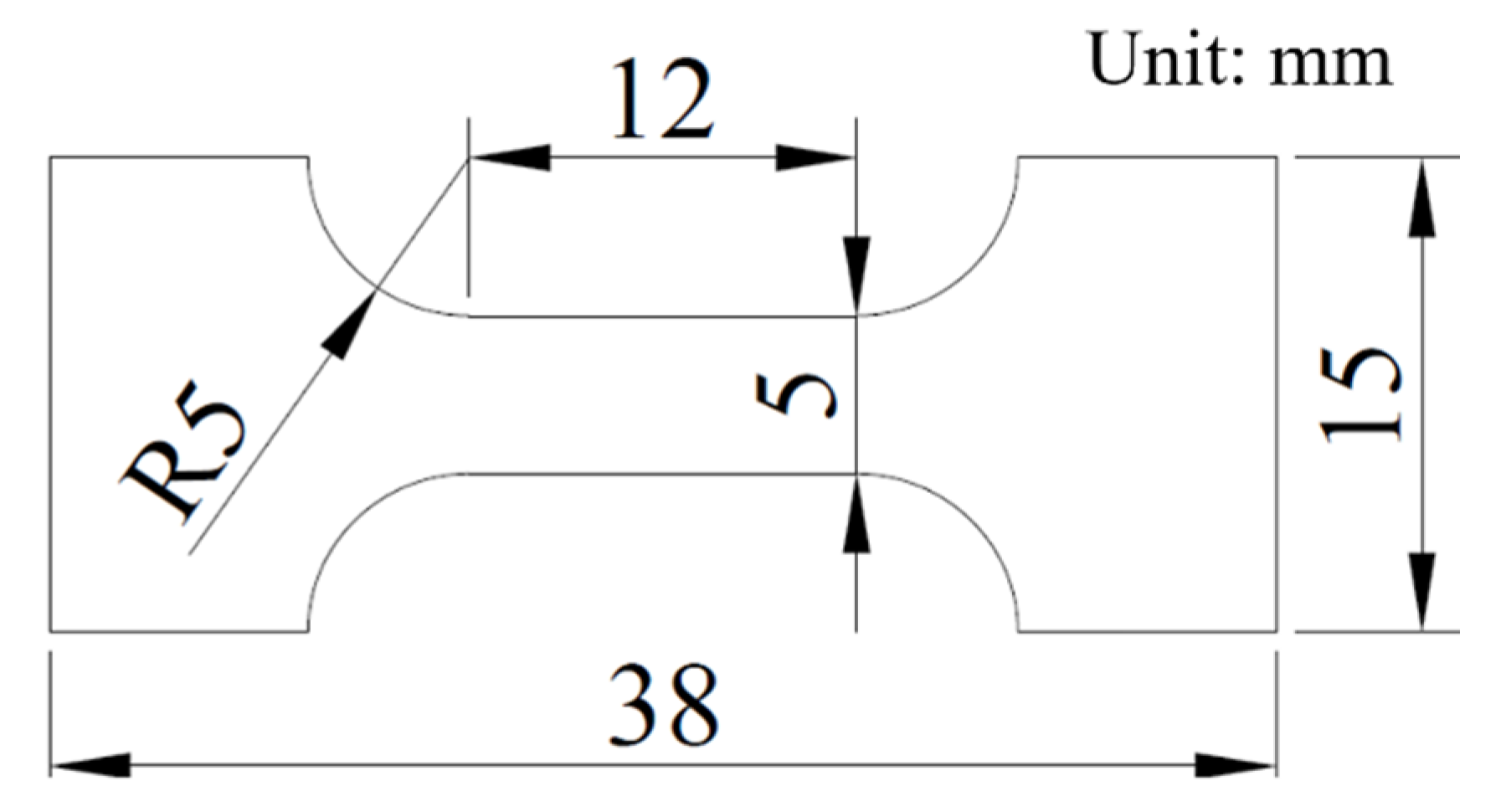
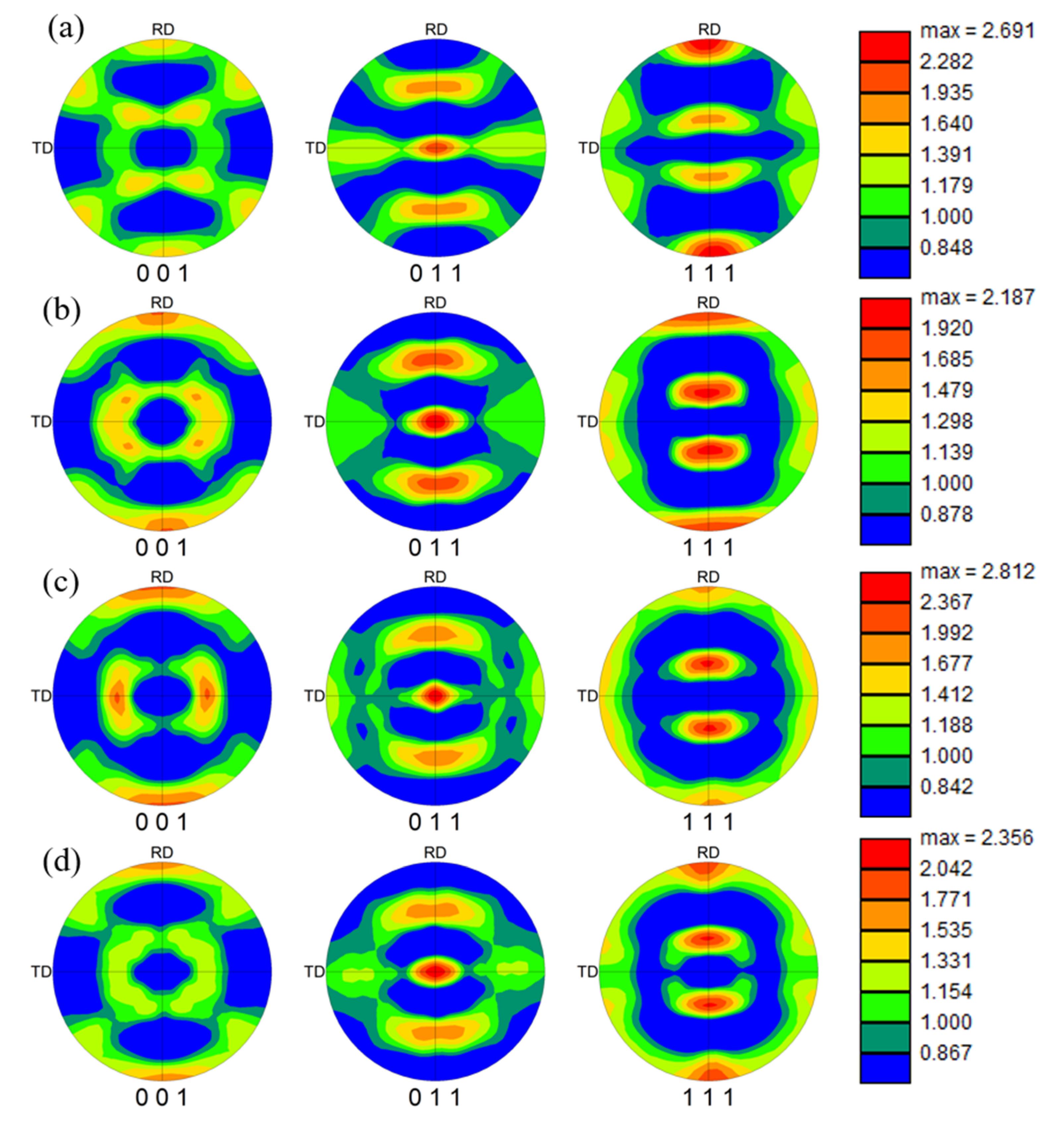

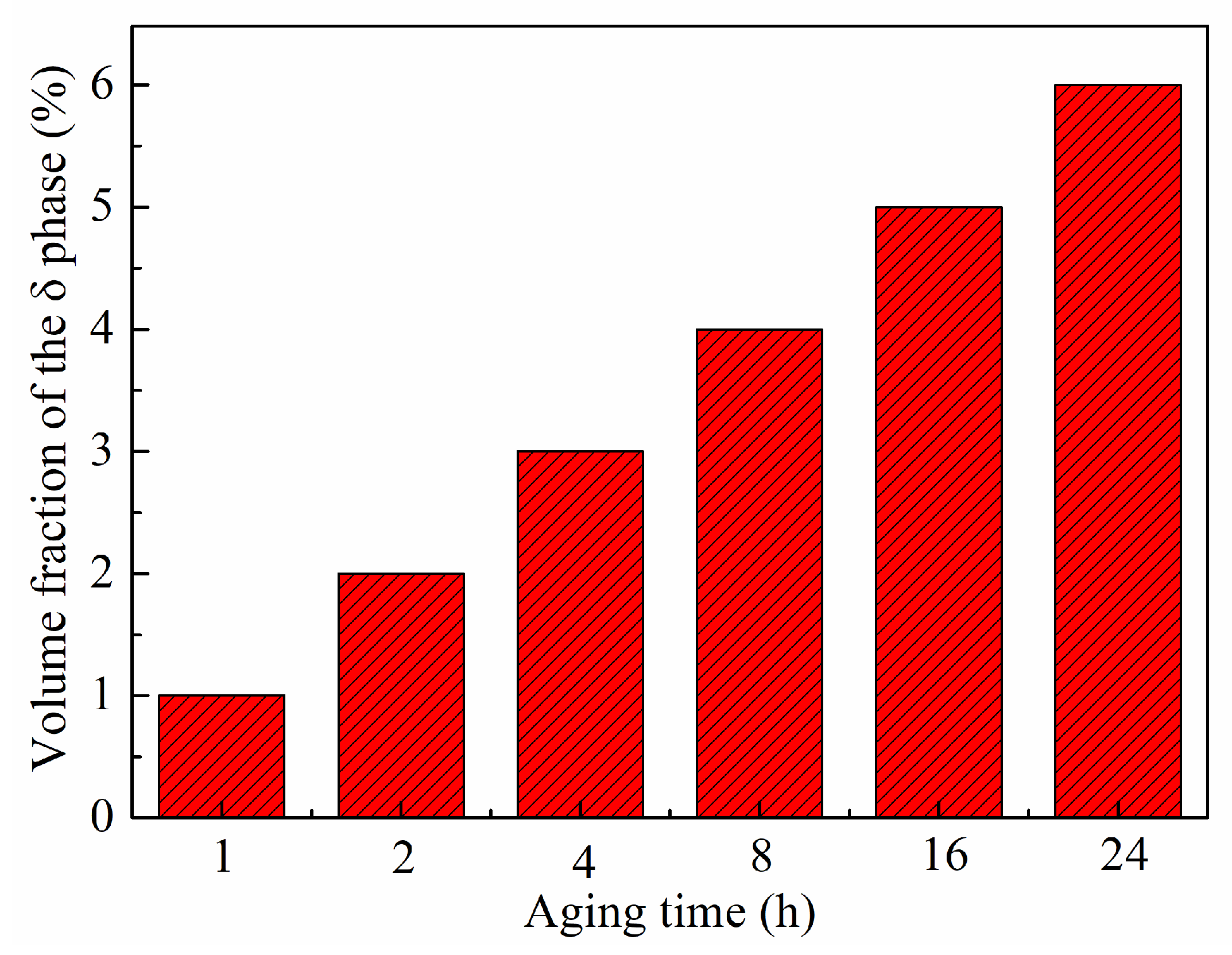
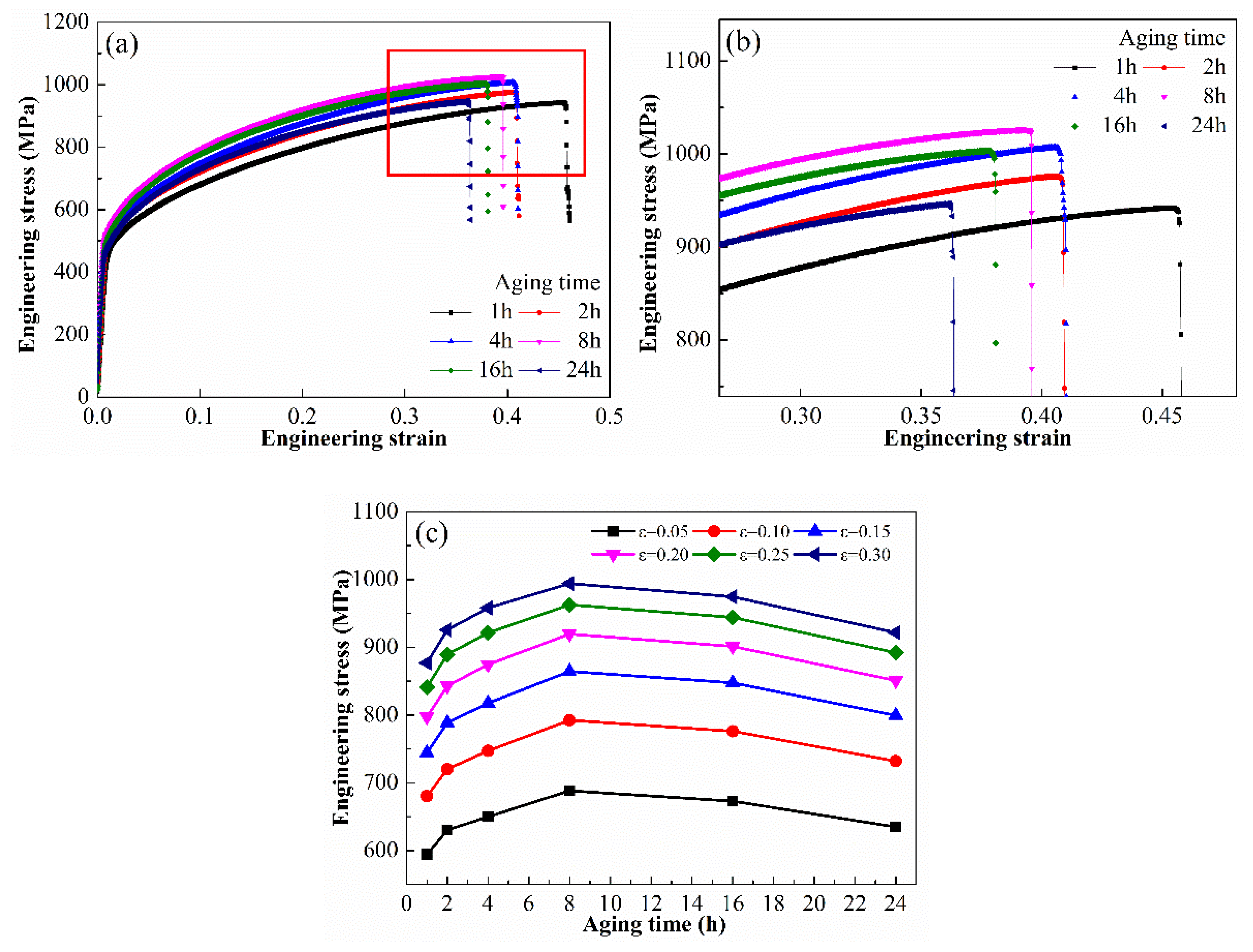
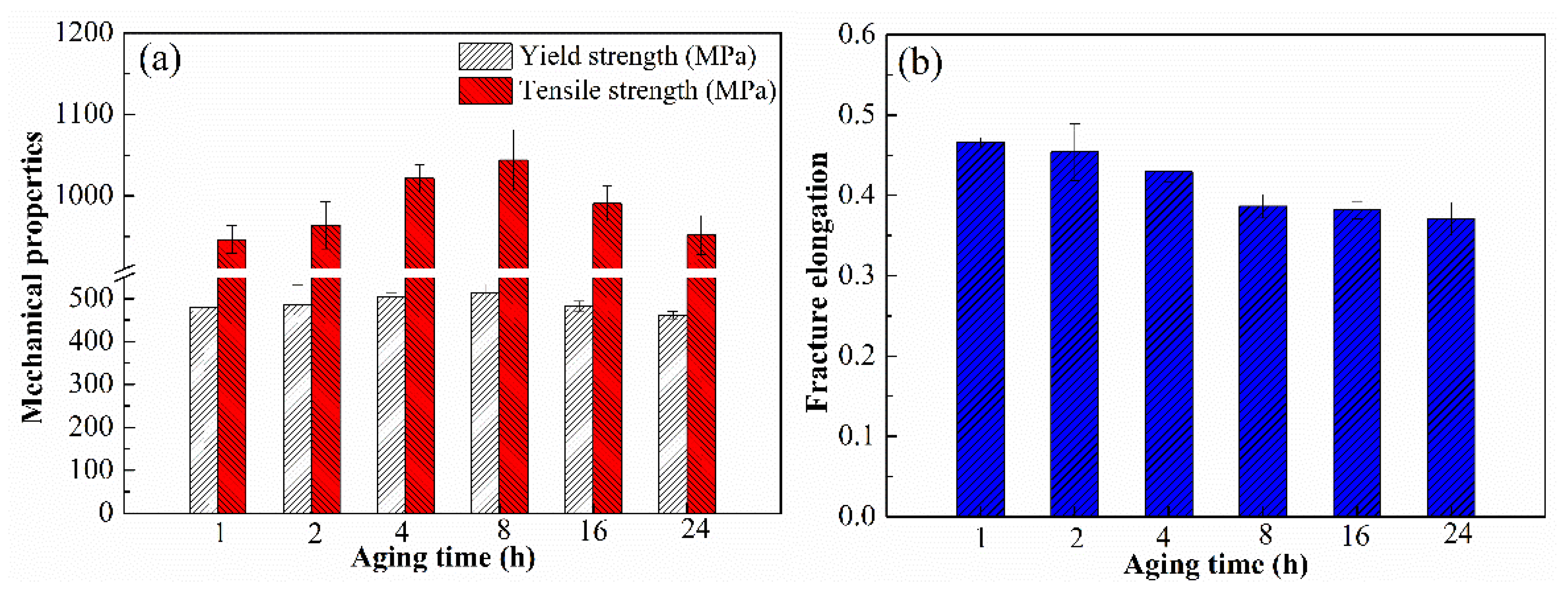
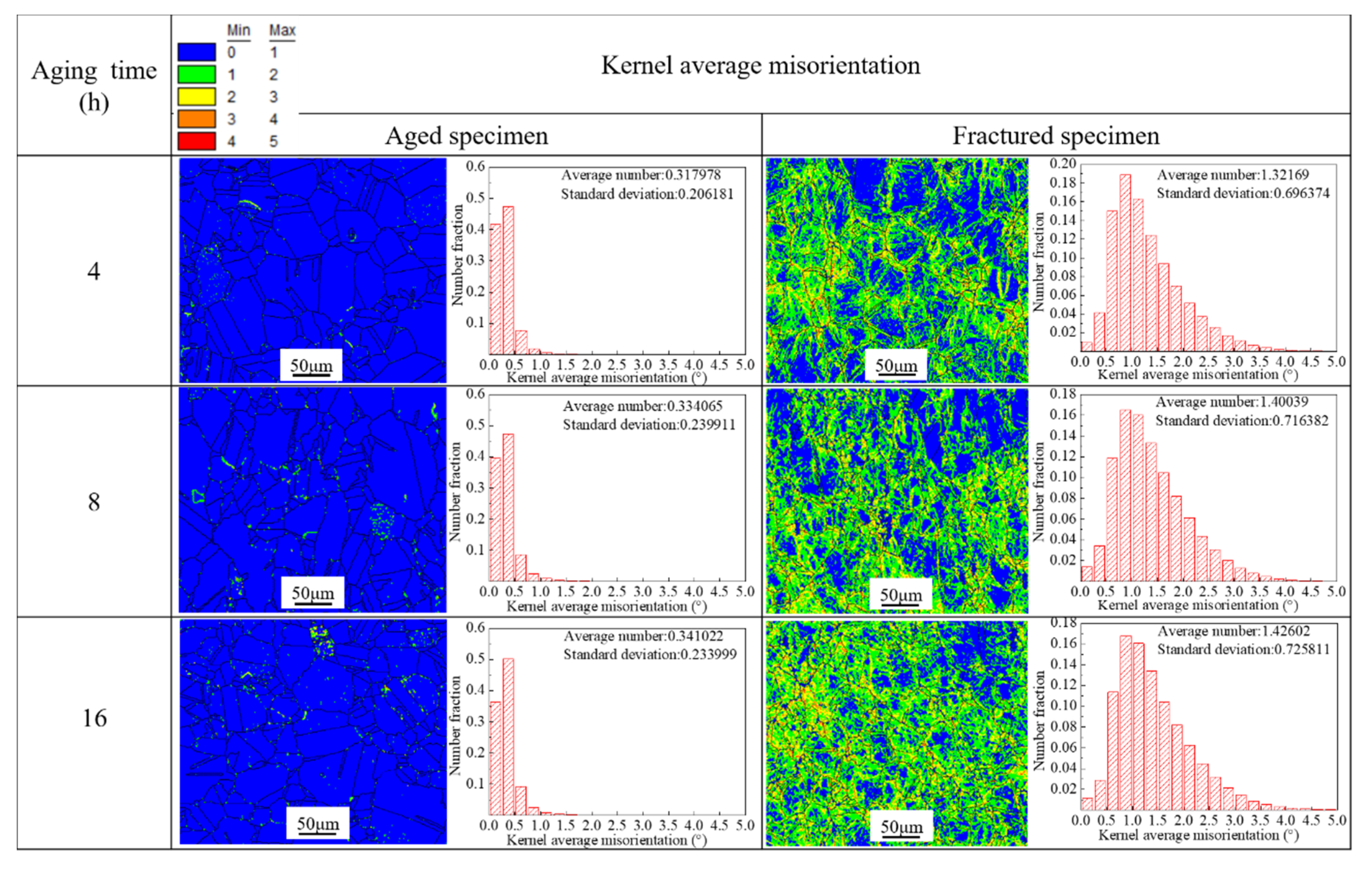
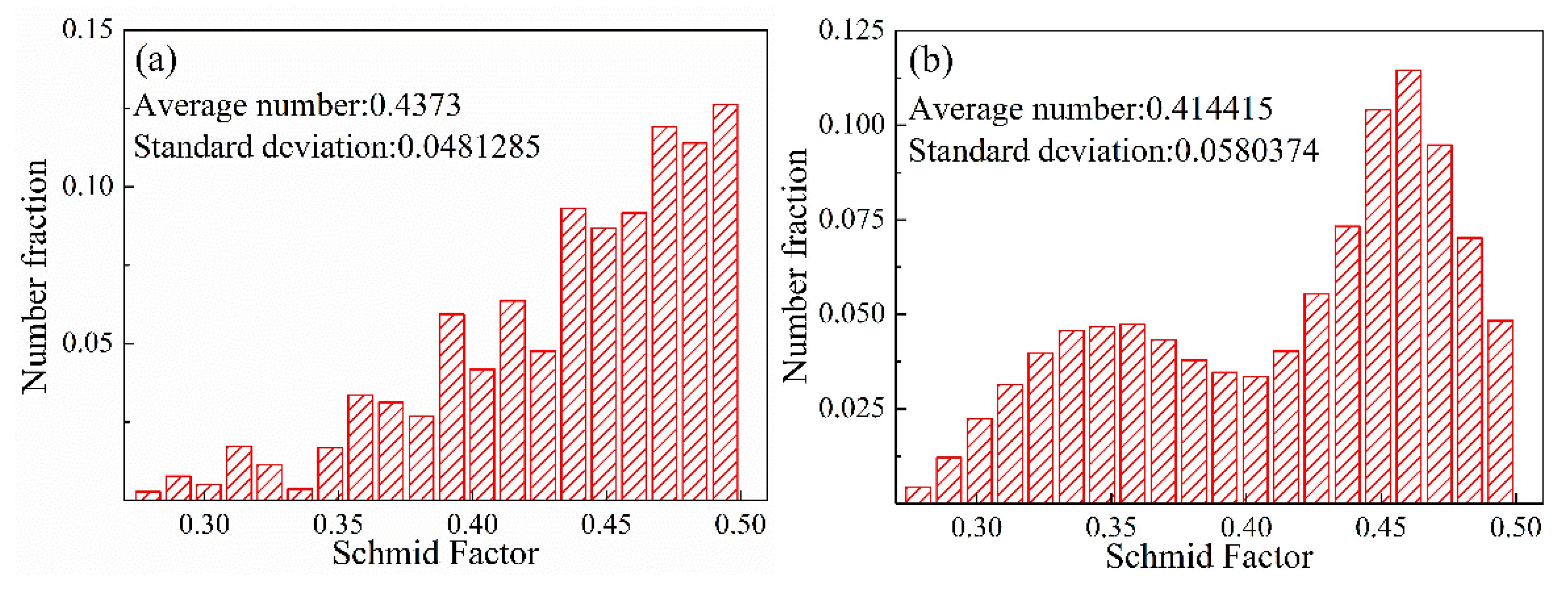
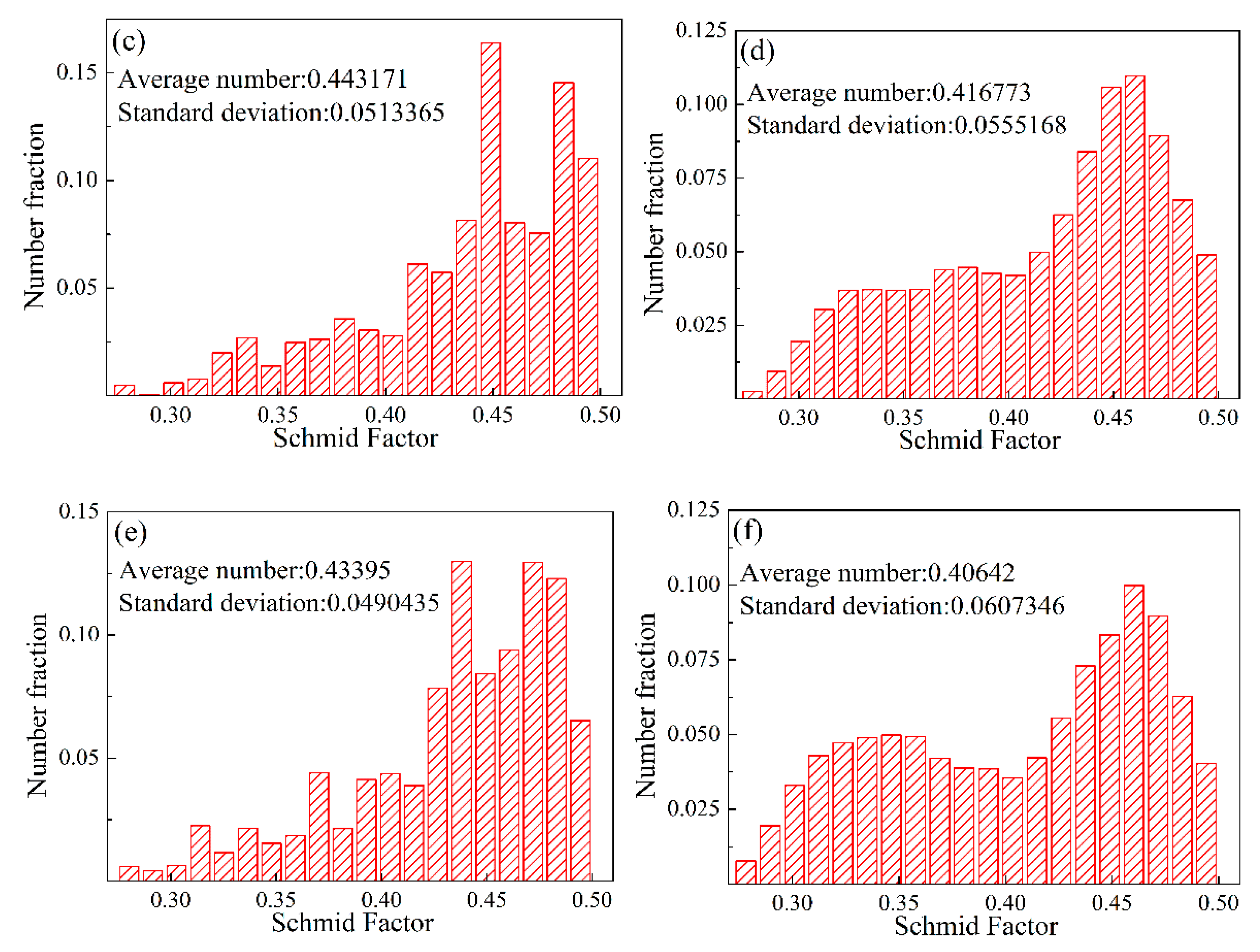
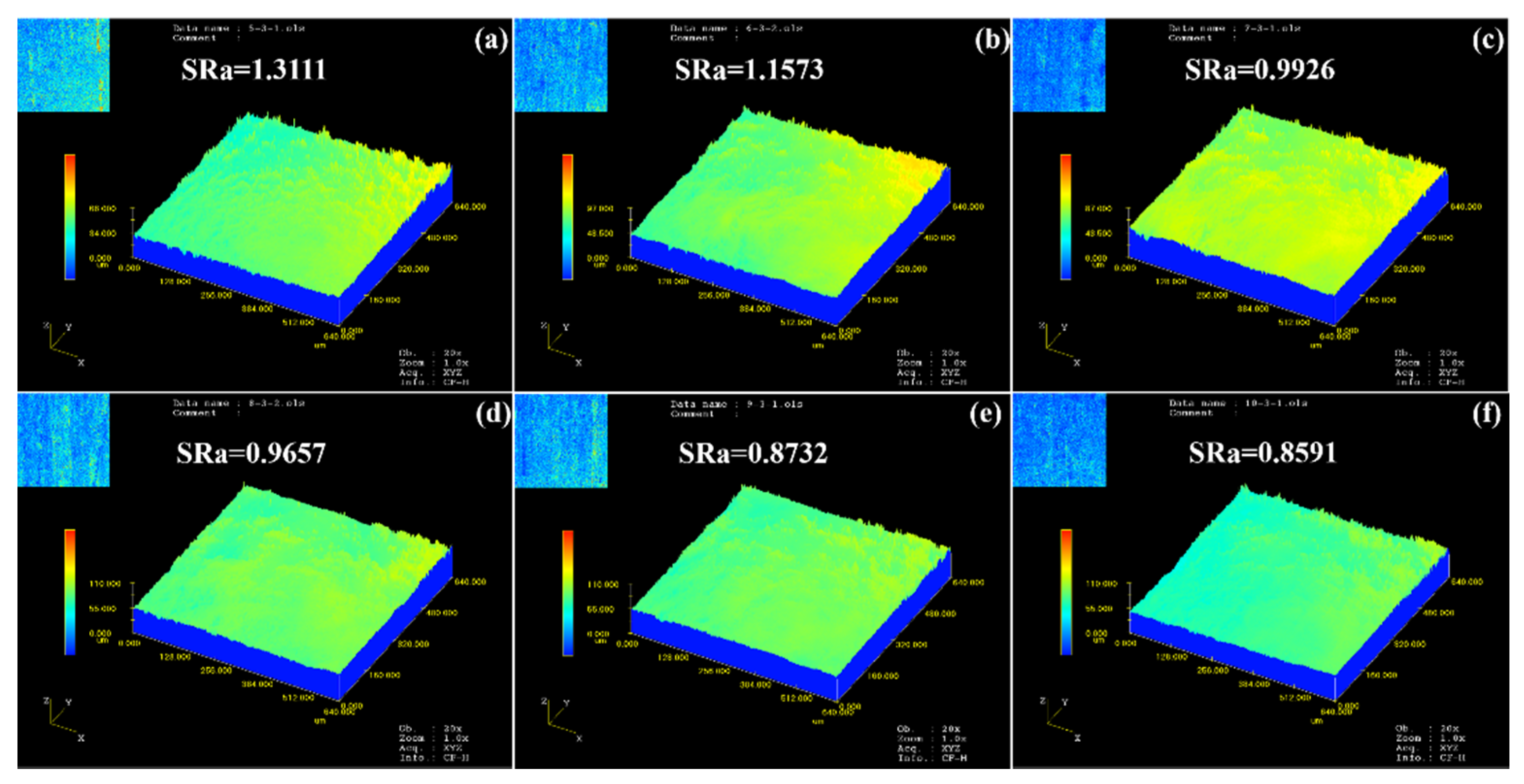
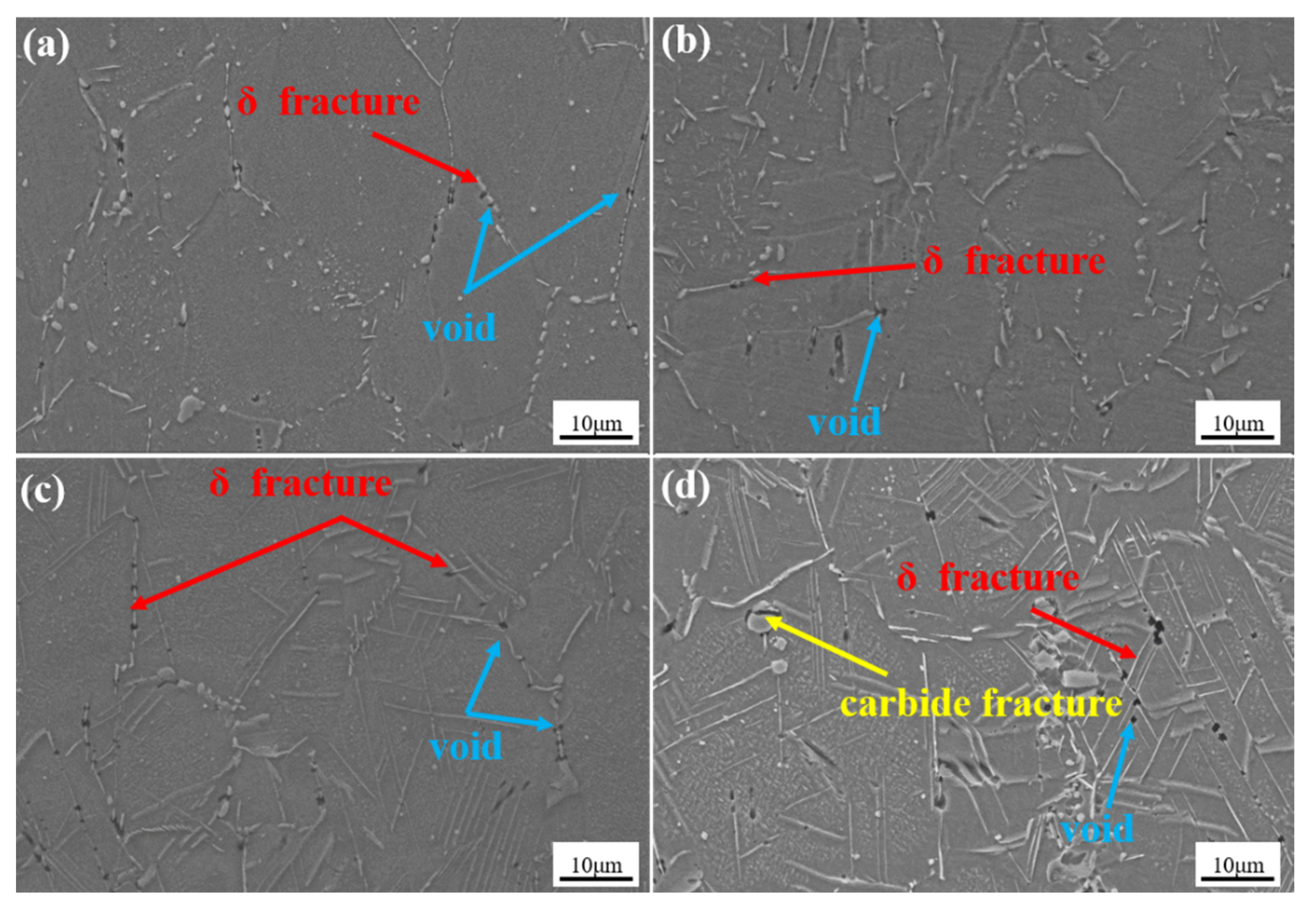
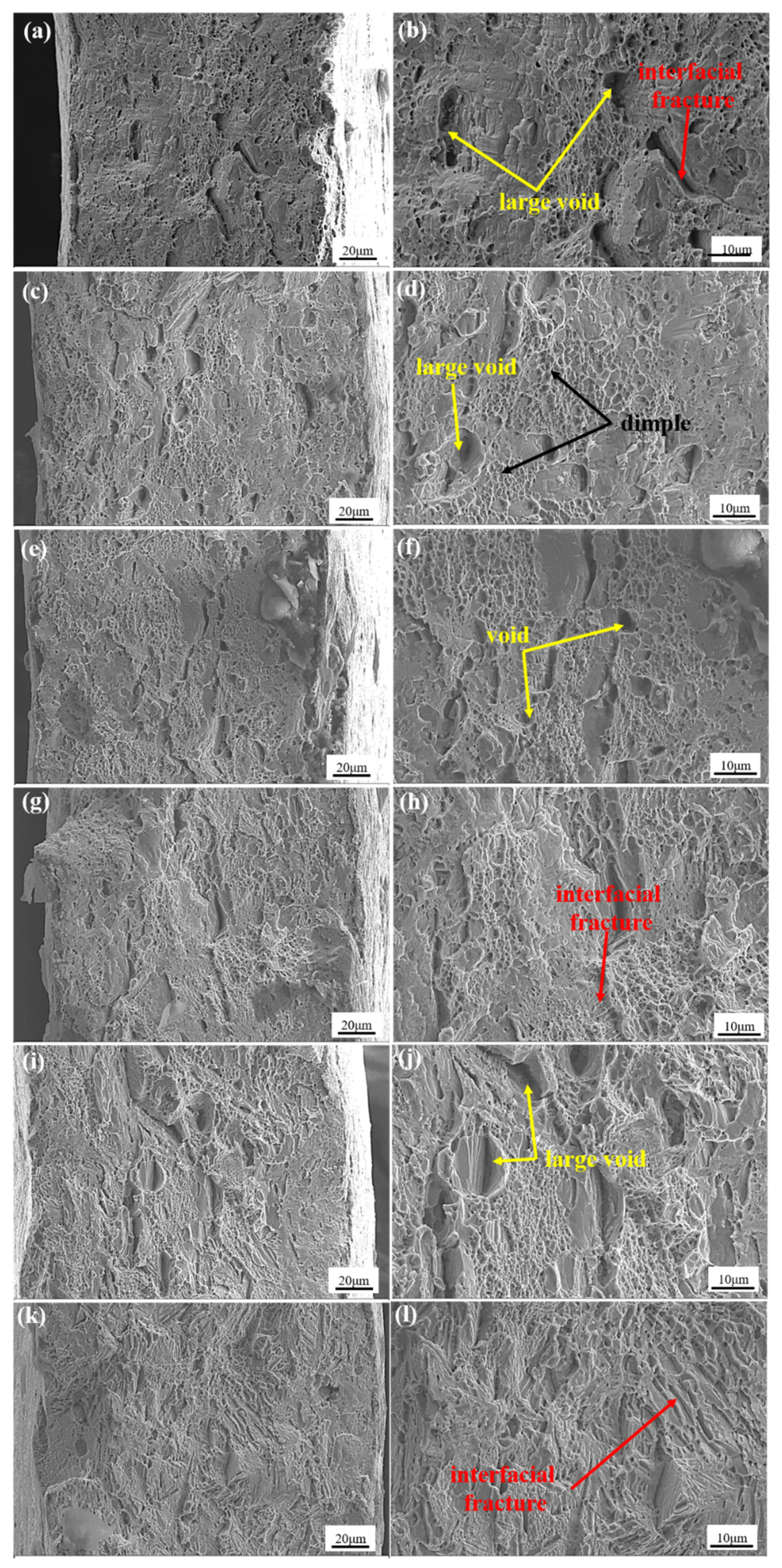
| Ni | Cr | Nb | Mo | Al | Ti | C | Co | Fe |
|---|---|---|---|---|---|---|---|---|
| 52.80 | 18.73 | 5.24 | 3.02 | 0.52 | 0.95 | 0.03 | 0.03 | 18.68 |
© 2019 by the authors. Licensee MDPI, Basel, Switzerland. This article is an open access article distributed under the terms and conditions of the Creative Commons Attribution (CC BY) license (http://creativecommons.org/licenses/by/4.0/).
Share and Cite
Zhu, Q.; Chen, G.; Wang, C.; Cheng, L.; Qin, H.; Zhang, P. Effect of the δ Phase on the Tensile Properties of a Nickel-Based Superalloy. Metals 2019, 9, 1153. https://doi.org/10.3390/met9111153
Zhu Q, Chen G, Wang C, Cheng L, Qin H, Zhang P. Effect of the δ Phase on the Tensile Properties of a Nickel-Based Superalloy. Metals. 2019; 9(11):1153. https://doi.org/10.3390/met9111153
Chicago/Turabian StyleZhu, Qiang, Gang Chen, Chuanjie Wang, Lukuan Cheng, Heyong Qin, and Peng Zhang. 2019. "Effect of the δ Phase on the Tensile Properties of a Nickel-Based Superalloy" Metals 9, no. 11: 1153. https://doi.org/10.3390/met9111153
APA StyleZhu, Q., Chen, G., Wang, C., Cheng, L., Qin, H., & Zhang, P. (2019). Effect of the δ Phase on the Tensile Properties of a Nickel-Based Superalloy. Metals, 9(11), 1153. https://doi.org/10.3390/met9111153







